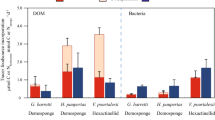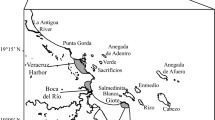Abstract
To get a better understanding of sponge feeding biology and efficiencies, the fatty acid (FA) composition and 13C natural abundance of sponges and of suspended particulate matter (SPM) from surrounding seawater was studied in different seasons at three locations. Haliclona oculata and Haliclona xena from the Oosterschelde, the Netherlands, Halichondria panicea and H. xena from Lake Veere, the Netherlands, and Aplysina aerophoba and Dysidea avara from the Mediterranean, Spain, were studied. Several FA biomarkers for different algal groups, bacteria and sponge biomass were identified in all sponges. The FA concentration variation in sponges was related to changes in fatty acid concentration in SPM. Stable carbon isotopic ratios (δ13C) in sponge specific FAs showed very limited seasonal variation at all sites. Algal FAs in sponges were mainly acquired from the SPM through active filtration in all seasons. At the two sites in the Netherlands only in May (spring), the sponge specific FAs had similar δ13C ratios as algal FAs, suggesting that sponges were mainly growing during spring and probably summer. During autumn and winter, they were still actively filtering, but the food collected during this period had little effect on sponge δ13C values suggesting limited incorporation of filtered material into the sponge body. The sponge A. aerophoba relied mostly on the symbiotic bacteria. In conclusion, fatty acid composition in combination with stable carbon isotope analysis can be used to analyze the food source of sponges.







Similar content being viewed by others
References
Abraham W, Hesse C, Pelz O (1998) Ratios of carbon isotopes in microbial lipids as indicator of substrate usage. Appl Environm Microbiol 64(11):4202–4209
Bergé JP, Barnathan G (2005) Fatty acids from lipids of marine organism: molecular biodiversity, roles as biomarkers, biologically active compounds, and economical aspects. Adv Biochem Engin Biotechnol 96:49–125
Bergquist PR, Lawson MP, Lavis A, Cambie RC (1984) Fatty acid composition and the classification of the Porifera. Biochem Systemat Ecol 12(1):63–84
Boschker HTS, Middelburg JJ (2002) Stable isotopes and biomarkers in microbial ecology. FEMS Microbiol Ecol 40:85–95
Boschker HTS, de Brouwer JFC, Cappenberg TE (1999) The contribution of macrophyte-derived organic matter to microbial biomass in salt-marsh sediments: stable carbon isotope analysis of microbial biomarkers. Limnol Oceanogr 44(2):309–319
Christie WW, Brechany EY, Stefanov K, Popov S (1992) The fatty acids of the sponge Dysidea fragilis from the Black Sea. Lipids 27(8):640–644
Cliff G (1982) Seasonal variation in the contribution of phytoplankton, bacteria, detritus and inorganic nutrients to a rocky shore ecosystem. Trans Roy Soc S Afr 44(4):523–538
Dasgupta A, Ayanoglu E, Wegmann-Szente A, Tomer KB, Djerassi C (1986) Mass spectral behavior and HPLC of some inusual molecular phospholipid species. Chem Phys Lipids 41:335–347
Dayton PK (1979) Observations of growth, dispersal and population dynamics of some sponges in McMurdo Sound, Antarctica. Colloques Internationaux du C.N.R.S. 291:271–282
De Goeij JM, Moodley L, Houtekamer M, Carballeira NM, van Duyl FC (2008) Tracing 13C-enriched dissolved and particulate organic carbon in the bacteria containing coral reef sponge Halisarca caerulea: Evidence for DOM feeding. Limnol Oceanogr 53(4):1376–1386
Delong EF, Yayanos AA (1986) American society for microbiology biochemical function and ecological significance of novel bacterial lipids in deep-sea procaryotes. Appl Environm Microbiol 51(4):730–737
Djerassi C, Lam W (1991) Sponge phospholipids. Acc Chem Res 24:69–75
Hahn S, Stoilov IL, Ha TBT, Readerstorff D, Doss GA, Li HT, Djerassi C (1988) Biosynthetic studies of marine lipids. 171. The course of chain elongation and desaturation in long chain fatty aicds of marine sponges. J Am Chem Soc 110:8117–8124
Hellings LF, Dehairs M, Tackx M, Keppens E, Baeyens W (1999) Origin and fate of organic carbon in the freshwater part of the Scheldt Estuary as traced by stable carbon isotope composition. Biogeochem 47:167–186
Hentshel U, Hopke J, Horn M, Friedrich AB, Wagner M, Hacker J, Moore BS (2002) Molecular evidence for a uniform microbial community in sponges from different oceans. Appl Environm Microbiol 68(9):4431–4440
Kharlamenko VI, Kiyashko SI, Rodkina SA, Imbs AB (2008) Determination of food sources of marine invertebrates from a subtidal sand community using analyses of fatty acids and stable isotopes. Russ J Mar Biol 34(2):101–109
Koopmans M, Wijffels RH (2008) Seasonal growth rate of the sponge Haliclona oculata (Demospongiae: Haplosclerida). Mar Biotechnol 10:502–510
Koopmans M, Martens D, Wijffels RH (2009) Growth efficiency and carbon balance for the sponge Haliclona oculata. Mar Biotechnol 12(3):340–349
Koopmans M, Martens D, Wijffels RH (2010) Towards commercial production of sponge medicines. Mar Drugs 7(4):787–802
Koopmans M, van Rijswijk P, Martens D, Egorova-Zachernyuk TA, Middelburg JJ, Wijffels RH (2011) Carbon conversion and metabolic rate in two marine sponges. Mar Biol 158(1):9–20
Nechev J, Christie WW, Robaina R, Popoc S, Stefanov K (2002) Lipid composition of the sponge Verongida aerophoba from the Canary Islands. Eur J Lipid Sci Technol 104:800–807
Peterson BJ, Fry B (1987) Stable isotopes in ecosystem studies. Ann Rev Ecol Syst 18:239–320
Ribes M, Coma R, Gili JM (1999) Natural diet and grazing rate of the temperate sponge Dysidea avara (Demospongiae, Dendroceratida) throughout an annual cycle. Mar Ecol Prog Ser 176:179–190
Riisgård HU, Thomassen S, Jakobsen H, Weeks JM, Larsen PS (1993) Suspension feeding in marine sponges Halichondria panicea and Haliclona urceolus: effects of temperature on filtration rate and energy cost of pumping. Mar Ecol Prog Ser 96:177–188
Rod’kina SA (2005) Fatty acids and other lipids of marine sponges. Russ J Mar Biol 31(1):S49–S60
Rod’kina SA, Latyshev NA, Imbs AB (2003) Fatty acids from the sea sponge Halichondria panicea. Russ J Bioorg Chem 29(4):382–386
Sipkema D, Franssen MCR, Osinga R, Tramper J, Wijffels RH (2005) Marine sponges as pharmacy. Mar Biotechnol 7:142–162
Thurber AR (2007) Diets of antartic sponges: links between the pelagic microbial loop and benthic metazoan food web. Mar Ecol Prog Ser 351:77–89
www.lipidlibrary.co.uk For mass spectra of methyl and picolinyl fatty acids.
Acknowledgments
This study was funded by NWO-ALW (814.02.010). We thank the Waterboard Zeeuwse Eilanden and the province of Zeeland for issuing the necessary permits. We thank S. de Caralt and J. Sanchez for collecting the sponges in the Mediterranean. Thanks to the Netherlands institute for ecology for providing equipment for the extraction and analysis of the fatty acids and P. van Breugel for his analytical assistance.
Author information
Authors and Affiliations
Corresponding author
Rights and permissions
About this article
Cite this article
Koopmans, M., van Rijswijk, P., Boschker, H.T.S. et al. Seasonal Variation of Fatty Acids and Stable Carbon Isotopes in Sponges as Indicators for Nutrition: Biomarkers in Sponges Identified. Mar Biotechnol 17, 43–54 (2015). https://doi.org/10.1007/s10126-014-9594-8
Received:
Accepted:
Published:
Issue Date:
DOI: https://doi.org/10.1007/s10126-014-9594-8




